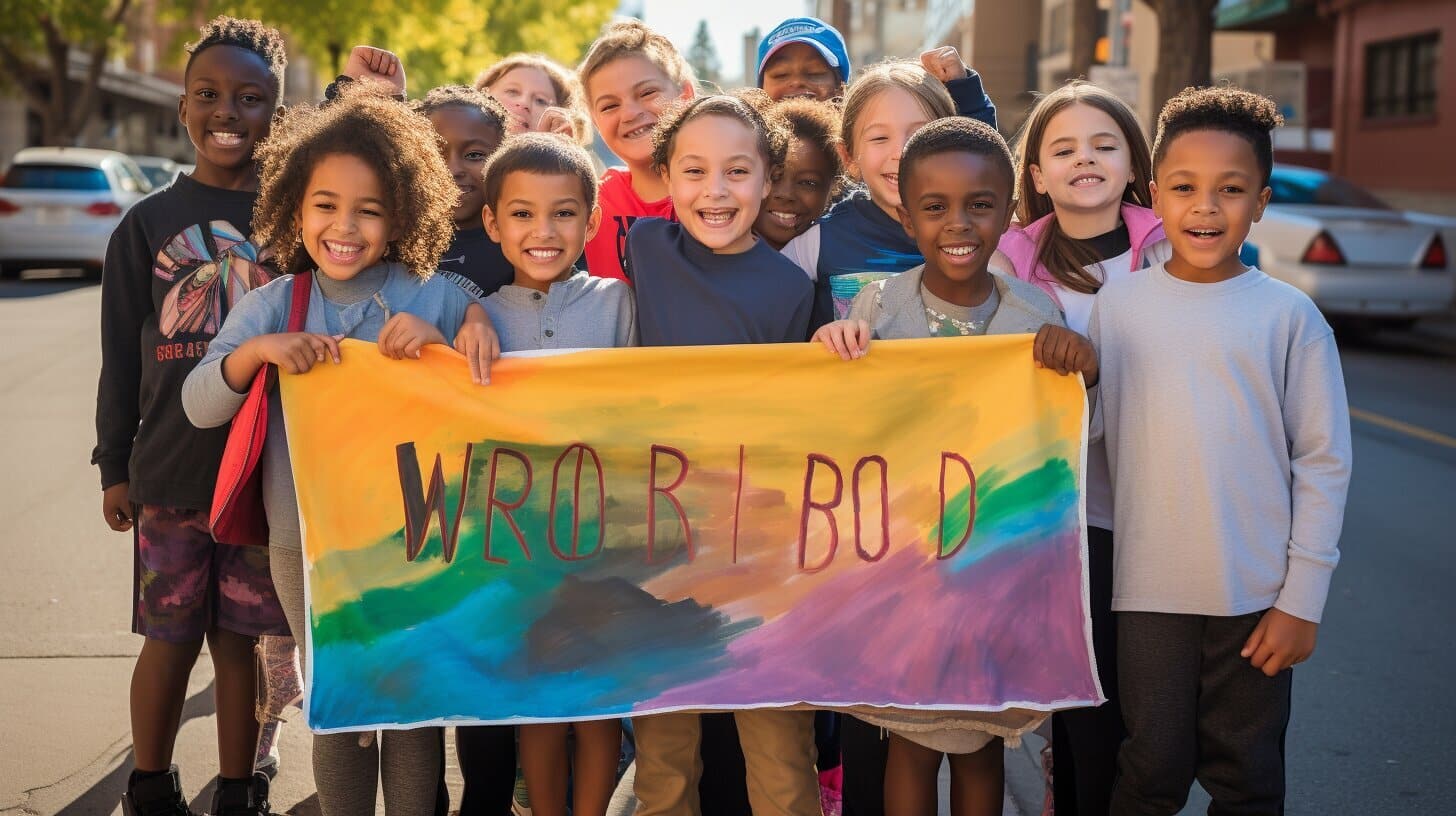As a parent, you want your child to have a healthy sense of self-worth and confidence. Part of this includes understanding the concept of pride. However, explaining pride to a child can be challenging. How do you articulate this abstract concept in a way that is relatable and understandable?
In this section, we will provide you with tips and strategies on how to effectively explain pride to your child. By the end, you will have a better understanding of how to teach your child about pride, and how to help them develop a healthy sense of self-worth.
Key Takeaways:
- Explaining pride to a child can be challenging, but it’s important for their healthy sense of self-worth and confidence.
- In this section, we will provide you with tips and strategies on how to effectively explain the concept of pride to your child.
- By fostering a supportive environment, encouraging self-acceptance and humility, and connecting pride to effort and achievement, you can help your child develop a healthy sense of pride.
Understanding the Meaning of Pride
Before you can explain pride to your child, it’s important to understand what it means. Pride is a feeling of satisfaction or accomplishment in oneself or someone else. This feeling can come from achieving a goal or doing something well.
For young children, pride can be associated with things like learning a new skill, completing a task, or winning a game. It’s important to note that pride is different from arrogance or boasting, which involves putting oneself above others.
One way to help your child understand pride is to use examples from their life. For instance, if your child learned how to spell their name, you can express your pride in their accomplishment and explain how that feeling is what pride means.
It’s also helpful to emphasize that pride is not only about winning or succeeding, but also about effort and improvement. Encourage your child to take pride in their efforts and progress, regardless of the outcome.

“Pride is a feeling of satisfaction or accomplishment in oneself or someone else.”
Introduce Positive Experiences
One of the best ways to teach children about pride is to help them identify positive experiences that make them feel proud. Encourage your child to think about moments when they accomplished something, helped someone, or overcame a challenge. This could be as simple as getting a good grade in school or learning a new skill such as riding a bike.
It’s important to validate your child’s feelings of pride and celebrate their accomplishments with them. This will help them develop a sense of self-worth and confidence in their abilities.
When talking about positive experiences, emphasize the effort and hard work that went into achieving the end result. This will help your child understand that pride is not just about the outcome, but also about the journey and the process of getting there.

Image source: seowriting.ai
Differentiate Between Healthy and Unhealthy Pride
As you teach your child about pride, it’s important to differentiate between healthy and unhealthy pride. Healthy pride involves feeling good about oneself for positive reasons, such as achieving a goal or making progress in a skill. Unhealthy pride, on the other hand, is characterized by arrogance, boastfulness, and putting others down to make oneself feel better.
One way to help your child understand the difference is by providing examples of each. For instance, you might say, “It’s okay to feel proud of yourself when you do well on a test because you worked hard and earned a good grade. But it’s not okay to brag about your grade and make others feel bad for not doing as well.”
Encouraging your child to focus on their own accomplishments and progress, rather than comparing themselves to others, can also help cultivate healthy pride. Remind your child that everyone has their own strengths and weaknesses, and that it’s important to appreciate their own unique qualities and abilities.
By helping your child understand the difference between healthy and unhealthy pride, you can promote a positive self-image and healthy relationships with others.

Encourage Self-Acceptance and Self-Appreciation
Teaching your child about pride should also involve fostering a healthy sense of self-acceptance and self-appreciation. Encourage your child to recognize their strengths and positive qualities, and to celebrate them. This can help boost their self-esteem and confidence, which are important factors in feeling a sense of pride.
One way to do this is by giving your child positive affirmations regularly. Let them know what you admire about them and why. For example, you could say something like “I am so proud of you for working hard on your school project. You are so creative and determined.”
Another way to encourage self-acceptance and self-appreciation is by allowing your child to express themselves freely. Let them explore their interests and hobbies, even if they may not align with your own preferences. Avoid criticizing or dismissing their choices, and instead show interest in what they are doing and encourage them to pursue their passions.
Remember that a healthy sense of pride comes from within, and helping your child develop confidence and self-acceptance can go a long way in fostering that pride.

Teach Gratitude and Humility
While it’s important for children to feel proud of their accomplishments and abilities, it’s equally important to teach them about the value of gratitude and humility. Encouraging a balanced understanding of pride will help children develop a healthy and positive sense of self-confidence.
Gratitude involves recognizing and appreciating the positive things in one’s life, including the people, experiences, and opportunities that have contributed to their success. By teaching children to express gratitude, you can help them develop a sense of appreciation and recognition for the efforts of others in their lives.
Humility involves recognizing that one’s accomplishments are not solely the result of their own efforts, but also the result of the support and guidance of others. By teaching children to be humble, you can help them develop a sense of respect and gratitude for the contributions of others, while also recognizing their own unique strengths and abilities.
Encouraging gratitude and humility can be as simple as saying “thank you” and giving credit to others when appropriate. You can also encourage your child to reflect on the people and experiences that have helped them achieve success, and to think about ways they can give back to their community and support others. By teaching children the importance of gratitude and humility, you can help them develop a well-rounded understanding of pride and self-confidence.

Connect Pride to Effort and Achievement
As a parent, you can help your child understand how pride is connected to effort and achievement. It’s important to emphasize the value of hard work and persistence when it comes to feeling proud of oneself.
One way to do this is to encourage your child to set goals and work towards achieving them. When they accomplish their goals, celebrate their achievements and let them know how proud you are of their efforts.
| Tip: | Use positive reinforcement to encourage your child’s efforts. Praise their hard work and determination, and offer encouragement when faced with challenges or setbacks. |
|---|
It’s also important to teach your child that not every accomplishment will come easily or quickly. Sometimes, it may take a lot of time and effort to achieve a goal, but the feeling of pride that comes with it is worth it in the end.

Remember to also emphasize the process of achieving a goal, rather than just the end result. Encourage your child to reflect on the steps they took to reach their goal and acknowledge the effort they put in along the way.
“The only way to do great work is to love what you do. If you haven’t found it yet, keep looking. Don’t settle. As with all matters of the heart, you’ll know when you find it.” – Steve Jobs
By connecting pride to effort and achievement, you can help your child develop a healthy sense of pride that is grounded in hard work and determination.
Share Personal Stories and Examples
One of the most effective ways to help your child understand the concept of pride is by sharing personal stories and examples. You can talk about times when you felt proud of yourself, such as when you accomplished a difficult task at work or when you overcame a personal challenge. By sharing these experiences, you can help your child see that pride is a natural and healthy emotion that everyone experiences.
You can also share stories about people you admire who demonstrate pride in positive ways. For example, you might talk about a famous scientist who worked tirelessly to make an important discovery or an athlete who trained hard to win a championship. By providing these examples, you can help your child understand that pride can be associated with effort and achievement.
 Sharing personal stories and examples can help your child understand the concept of pride.
Sharing personal stories and examples can help your child understand the concept of pride.Foster a Supportive Environment
Creating a supportive environment is key to teaching children about pride. When kids feel that their feelings are validated and that they have a safe space to express themselves, they are more likely to develop a positive sense of self-worth and pride.
You can foster a supportive environment by practicing active listening and encouraging your child to share their thoughts and feelings with you. When they do share with you, make sure to validate their feelings and show them that you care.
Additionally, be mindful of the language you use when speaking to your child. Avoid negative language or criticism that can damage their sense of self-worth. Instead, focus on using positive reinforcement and praise their efforts and accomplishments.
It’s also important to celebrate your child’s achievements and accomplishments. This can be as simple as giving them a high-five or a hug, or even throwing a small celebration. By doing this, you are showing your child that you are proud of them and that their accomplishments matter.

Remember that creating a supportive environment takes time and effort, but it’s worth it to help your child develop a healthy sense of self-worth and pride.
Encourage Expressing and Celebrating Achievements
One effective way to teach children about pride is by encouraging them to express and celebrate their achievements. This allows them to recognize their hard work and dedication, which in turn, can foster a sense of pride.
Start by creating a space where your child feels comfortable sharing their accomplishments with you. This can be as simple as a whiteboard in their room where they can write down their achievements or a special dinner where they get to share their successes.
When your child does achieve something, take the time to celebrate with them. This can be as simple as a high-five or a hug, or it can involve a small treat or reward, like going out for ice cream or playing a special game together.
Remember to also encourage your child to celebrate the achievements of others. This can help develop a sense of empathy and respect for the accomplishments of others, which can contribute to a healthy sense of pride.
By encouraging your child to express and celebrate their achievements, you can help them develop a healthy sense of pride and self-worth. This can also create a positive and supportive environment that promotes the expression and celebration of achievements.

Conclusion
Teaching your child about pride can be a fulfilling and empowering experience. By following these tips and strategies, you can help your child develop a healthy sense of pride that will serve them well throughout their life. It’s important to encourage your child to express their feelings of pride and celebrate their achievements in a supportive environment. Remember to differentiate between healthy and unhealthy pride and foster humility and gratitude alongside pride. By sharing personal stories and examples, you can make the concept of pride more relatable to your child. Keep up the good work and enjoy watching your child grow in confidence and self-appreciation.
Can Teaching a Child About Pride Help Them Understand Humility?
Teaching a child about pride can indeed be a stepping stone to explaining humility to a child. By highlighting the importance of acknowledging their achievements and being confident, we can also emphasize the value of empathy, understanding, and the ability to learn from others. Striking a balance between pride and humility helps children appreciate their own worth while respecting and valuing those around them.
FAQ
Q: How can I explain the meaning of pride to my child?
A: Explaining pride to a child can be done by introducing positive experiences and teaching them to recognize moments where they feel proud of themselves.
Q: What is the difference between healthy and unhealthy pride?
A: Healthy pride is feeling proud of oneself for achievements or hard work, while unhealthy pride involves arrogance or boastfulness.
Q: How can I teach my child self-acceptance and self-appreciation?
A: Encouraging self-acceptance and self-appreciation can help children develop a healthy sense of pride. Parents can provide strategies such as focusing on their child’s strengths and encouraging them to embrace their unique qualities.
Q: Why is it important to teach gratitude and humility alongside pride?
A: Teaching gratitude and humility alongside pride helps children develop a balanced understanding of this emotion and promotes empathy towards others.
Q: How can I connect pride to effort and achievement?
A: Parents can explain to their children how pride can be associated with hard work, effort, and accomplishments, highlighting the value of persistence and dedication.
Q: How can I make the concept of pride more relatable to my child?
A: Sharing personal stories or examples that demonstrate pride can make the concept more relatable and understandable for children.
Q: How can I create a supportive environment for my child to express their feelings of pride?
A: It is important to create a supportive environment that encourages children to embrace and express their feelings of pride. This can be done by praising their efforts and achievements and celebrating their successes.
Q: How can I encourage my child to express and celebrate their achievements?
A: Parents can create opportunities for children to express and celebrate their achievements, such as organizing a small family celebration or creating a special display for their accomplishments.






